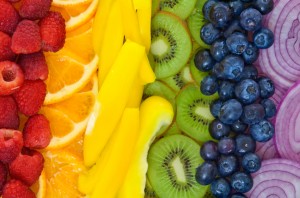So, in the spirit of taking something simple and making it complicated – looking at the health benefits of veggies inevitably leads to phytochemicals (What-o-chemicals??) Eat your greens quickly morphs into a science lesson. We all know that veggies are rich sources of the usual suspects, like vitamins, minerals and carbohydrates. But they also contain a number of bioactive compounds – these so-called phytochemicals – that can help protect the body from environmental damage and aging.
A quick look at the research and you’ll see names like carotenoids, phenolic compounds, flavonoids, isoflavones, lycopene, etc. It’s hard to know how much of each phytochemical is needed for optimal health, because the interactions between body, nutrients and phytochemical isn’t understood yet. Most nutritionists promote a balance and variety of vegetables as the ideal way to eat to keep in shape, stay fit and reduce your risk of ill health. So the answer is more like eat your greens, yellows, reds, oranges, purples and browns. A great summary of all the phytochemicals, what they do and how to get them is Super Nutrients Handbook by Lyndel Costain.
If you want to up the complexity factor even more there are a number of buzz-worthy systems for rating the worthiness of your veggies:
- The Glycemic Index indicates how quickly a food will effect a rise in blood glucose levels. The lower the GI, the more gradual the rise in blood glucose and the more sustained energy. Foods with a low GI are generally rich in soluble fiber and include oats, peas, beans, lentils, corn, pasta, rye, fruit, and granary breads, most fresh and dried fruit, noodles, granola and bran cereals. Researchers can’t predict the GI for combinations of foods, so mixing lower GI foods with higher ones can lessen the impact of your favorite high-GI foods.
xx
- ORAC (oxygen radical absorbance capacity) scores are a method of measuring the antioxidant capacity of fruit and vegetables. Foods are ranked according to their potential to mop up oxygen free radicals. Cocoa powder, then green tea, ranks highest. Top ORAC scores for fresh produce are: blueberries, blackberries, garlic, kale, strawberries, spinach, Brussels sprouts, alfalfa sprouts and broccoli. An ORAC score doesn’t give an indication of how many antioxidants a food has, but rather how efficiently a food can destroy free radicals. A food’s ORAC score is affected by a multitude of factors: growing conditions, how it is consumed, how soon after harvesting it is consumed, how it is stored, etc.
xx
- Whole Foods, Eat Right America and Dr. Joel Fuhrman have collaborated on the ANDI score – Aggregate Nutrient Density Index. This index is a complicated algorithm for the nutrient density of vitamins, minerals, a few phytochemicals, and ORAC scores. The three winners in this game are kale (a triple winner!), watercress and collard greens. The last time I was at Whole Foods I noticed the signs up in the produce department. Dr. Fuhrman’s word for people who love vegetables is nutritarians – which is unfortunate but probably worth overlooking.
xx
For those that prefer the bottom line – a home cooked meal, based primarily on whole foods, is your best health bet. As Michael Pollan noted: “Eat food. Not too much. Mostly plants.”

